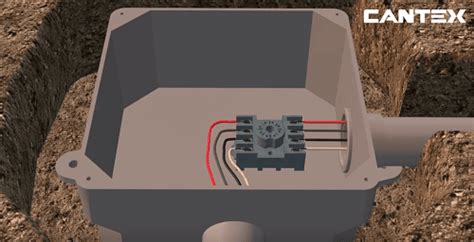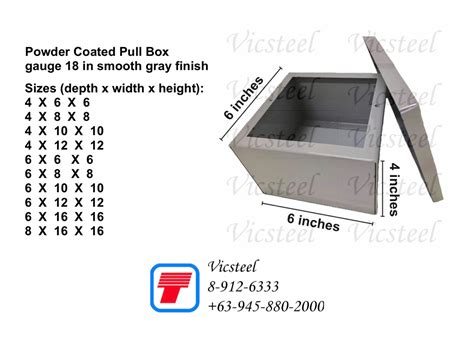all pull boxes junction boxes and fittings must be All pull boxes, junction boxes, and fittings shall be provided with covers. If metal covers are used, they shall be grounded. In energized installations each outlet box shall have a cover, . Many dyes contain metallic salts, which are atoms that have been chemically bonded to metal ions. These metallic salts give the dyes their color by absorbing light in the visible spectrum and reflecting back light in the infrared spectrum.
0 · utility box junction and pull
1 · underground electrical pull box installation
2 · standard electrical pull box sizes
3 · nec distance between pull boxes
4 · nec compliant junction boxes
5 · maximum distance between junction boxes
6 · electrical pull box size chart
7 · different types of pull boxes
The idea is that you drill a round hole for the connector, and next to it a small hole for the tab. This will prevent the connector from twisting. No idea what they're called, but BNC suppliers offer them as accessories.
All pull boxes, junction boxes, and fittings shall be provided with covers. If metal covers are used, they shall be grounded. In energized installations each outlet box shall have a cover, faceplate, or fixture canopy.All pull boxes, junction boxes, and fittings shall be provided with covers identified for the purpose. If metal covers are used, they shall be grounded. In completed installations, each outlet box .All pull boxes, junction boxes, and fittings shall be provided with covers. If metal covers are used, they shall be grounded. In energized installations each outlet box shall have a cover, . Answer: Paragraph (b)(3) of §1926.405 applies only to pull and junction boxes installed on systems of more than 600 volts. If none of the conductors within the box were over .
All pull boxes, junction boxes, and fittings shall be provided with covers identified for the purpose. If metal covers are used, they shall be grounded. In completed installations, each outlet box .
One acceptable method is a ground fault circuit interrupter (GFCI). Since conductors can be damaged if they rub against the sharp edges of cabinets, boxes, or fittings, they must be . All pull boxes, junction boxes, and fittings must be provided with covers approved for the purpose. If metal covers are used they must be grounded. In completed installations .All pull boxes, junction boxes, and fittings must have covers. Metal covers need to be grounded. In energized installations, each outlet box needs to have a cover, faceplate, or fixture canopy.
All pull boxes, junction boxes, and fittings must have covers. Metal covers need to be grounded. In energized installations, each outlet box needs to have a cover, faceplate, or fixture canopy.
All pull boxes, junction boxes, and fittings shall be provided with covers. If metal covers are used, they shall be grounded. In energized installations each outlet box shall have a cover, faceplate, or fixture canopy.All pull boxes, junction boxes, and fittings shall be provided with covers identified for the purpose. If metal covers are used, they shall be grounded. In completed installations, each outlet box shall have a cover, faceplate, or fixture canopy.All pull boxes, junction boxes, and fittings shall be provided with covers. If metal covers are used, they shall be grounded. In energized installations each outlet box shall have a cover, faceplate, or fixture canopy. Answer: Paragraph (b)(3) of §1926.405 applies only to pull and junction boxes installed on systems of more than 600 volts. If none of the conductors within the box were over 600 volts, then the requirement in question does not apply.
All pull boxes, junction boxes and fittings must be provided with covers approved for the purpose. If metal covers are used they must be grounded. In completed installations, each outlet box must have a cover, faceplate or fixture canopy.All pull boxes, junction boxes, and fittings shall be provided with covers identified for the purpose. If metal covers are used, they shall be grounded. In completed installations, each outlet box shall have a cover, faceplate, or fixture canopy.One acceptable method is a ground fault circuit interrupter (GFCI). Since conductors can be damaged if they rub against the sharp edges of cabinets, boxes, or fittings, they must be protected from damage where they enter. To protect the conductors, some type of clamp or rubber. grommet must be used. All pull boxes, junction boxes, and fittings must be provided with covers approved for the purpose. If metal covers are used they must be grounded. In completed installations each outlet box must have a cover, faceplate, or fixture canopy.
All pull boxes, junction boxes, and fittings must have covers. Metal covers need to be grounded. In energized installations, each outlet box needs to have a cover, faceplate, or fixture canopy.
utility box junction and pull
underground electrical pull box installation


All pull boxes, junction boxes, and fittings must have covers. Metal covers need to be grounded. In energized installations, each outlet box needs to have a cover, faceplate, or fixture canopy.
All pull boxes, junction boxes, and fittings shall be provided with covers. If metal covers are used, they shall be grounded. In energized installations each outlet box shall have a cover, faceplate, or fixture canopy.
All pull boxes, junction boxes, and fittings shall be provided with covers identified for the purpose. If metal covers are used, they shall be grounded. In completed installations, each outlet box shall have a cover, faceplate, or fixture canopy.
All pull boxes, junction boxes, and fittings shall be provided with covers. If metal covers are used, they shall be grounded. In energized installations each outlet box shall have a cover, faceplate, or fixture canopy.
Answer: Paragraph (b)(3) of §1926.405 applies only to pull and junction boxes installed on systems of more than 600 volts. If none of the conductors within the box were over 600 volts, then the requirement in question does not apply.All pull boxes, junction boxes and fittings must be provided with covers approved for the purpose. If metal covers are used they must be grounded. In completed installations, each outlet box must have a cover, faceplate or fixture canopy.All pull boxes, junction boxes, and fittings shall be provided with covers identified for the purpose. If metal covers are used, they shall be grounded. In completed installations, each outlet box shall have a cover, faceplate, or fixture canopy.One acceptable method is a ground fault circuit interrupter (GFCI). Since conductors can be damaged if they rub against the sharp edges of cabinets, boxes, or fittings, they must be protected from damage where they enter. To protect the conductors, some type of clamp or rubber. grommet must be used.
All pull boxes, junction boxes, and fittings must be provided with covers approved for the purpose. If metal covers are used they must be grounded. In completed installations each outlet box must have a cover, faceplate, or fixture canopy.All pull boxes, junction boxes, and fittings must have covers. Metal covers need to be grounded. In energized installations, each outlet box needs to have a cover, faceplate, or fixture canopy.

standard electrical pull box sizes
nec distance between pull boxes
See what color cabinets go with black stainless steel appliances, including different designs, ideal shades, paint combinations, and matching tips. Black stainless steel appliances are a big trend in kitchen designs today. And in all .
all pull boxes junction boxes and fittings must be|maximum distance between junction boxes